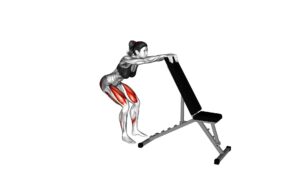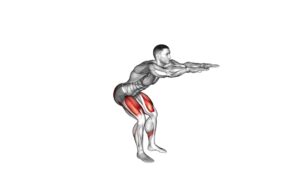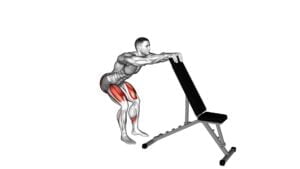Potty Squat (female) – Video Exercise Guide & Tips

Are you looking for an effective exercise to strengthen your lower body? Look no further than the potty squat.
Watch This Exercise Video
This video exercise guide will show you how to properly perform the potty squat and provide helpful tips for maintaining proper form and technique.
With progressions and variations included, you can easily incorporate the potty squat into your daily routine.
Get ready to feel the burn and see results with this powerful lower body workout.
Key Takeaways
- The Potty Squat strengthens and tones pelvic floor muscles.
- Proper form and technique involve standing with feet shoulder-width apart, bending knees and lowering the body down towards the ground, keeping the back straight and core engaged, and imagining sitting back onto an imaginary chair while engaging various muscle groups.
- Tips for proper form and technique include maintaining proper alignment, engaging core muscles throughout the exercise, modifying the exercise if needed for knee or back issues, starting with a comfortable depth and gradually increasing range of motion, and listening to the body's capabilities and making modifications as needed.
- Progressions and variations of the Potty Squat include adding resistance with dumbbells or kettlebells, performing on an unstable surface like a Bosu ball or balance board, trying explosive jump squats for power and explosiveness, incorporating single-leg potty squats for balance and stability, and adjusting intensity and difficulty as needed.
Benefits of the Potty Squat
Get ready to experience the numerous benefits of the Potty Squat! This simple yet effective exercise can greatly improve your pelvic floor and muscle activation. When you perform the Potty Squat, you activate the muscles in your pelvic floor, which can help strengthen and tone them over time. This is especially beneficial for women who've experienced childbirth or are dealing with issues like urinary incontinence.
The Potty Squat is a functional exercise that mimics the natural position our bodies are designed to be in when going to the bathroom. By squatting, you open up the pelvic floor and allow for proper alignment of the bowel and bladder. This can help prevent constipation and improve digestion.
Furthermore, the Potty Squat can also help with muscle activation in other areas of the body. When you squat, you engage your core, glutes, and leg muscles, which can contribute to overall strength and stability. It can also help improve your posture and balance.
Incorporating the Potty Squat into your regular exercise routine can have a positive impact on your pelvic floor health and muscle activation. So why wait? Start reaping the benefits of the Potty Squat today!
How to Perform the Potty Squat
To perform the Potty Squat, begin by standing with your feet shoulder-width apart. This exercise is a modification of the deep squat, which has numerous benefits for your body. Start by bending your knees and lowering your body down towards the ground, keeping your back straight and your core engaged.
As you lower yourself, imagine that you're sitting back onto an imaginary chair. Aim to lower your body as close to the ground as possible, while maintaining good form. This deep squat position engages your glutes, quadriceps, hamstrings, and calves. It also helps to improve flexibility in your hips, knees, and ankles. Additionally, the potty squat can help to strengthen your pelvic floor muscles and improve your balance.
Keep in mind that everyone's body is different, so it's important to listen to your own body's capabilities and make modifications as needed.
Now, let's move on to some tips for proper form and technique to get the most out of your Potty Squat.
Tips for Proper Form and Technique
To ensure proper form and technique while performing the Potty Squat, follow these tips.
- One common mistake isn't maintaining proper alignment throughout the exercise. Make sure your feet are shoulder-width apart and your knees are tracking over your toes. Avoid letting your knees collapse inward or pushing them too far forward.
- Another mistake isn't engaging your core muscles. To do this, imagine pulling your belly button towards your spine and keeping your torso upright throughout the movement.
- Additionally, it's important to modify the exercise if needed. If you have any knee or back issues, you can place a towel or cushion under your heels for support. You can also adapt the exercise by holding onto a sturdy object, like a countertop or chair, for balance.
- Remember to start with a comfortable depth and gradually increase the range of motion as you become more comfortable.
Progressions and Variations of the Potty Squat
To progress and vary your Potty Squat routine, you can incorporate different modifications and adaptations to challenge your muscles and improve your overall strength and stability.
Here are some potty squat modifications and advanced techniques that you can try.
One modification you can make is to add resistance to your potty squat. This can be done by holding a dumbbell or kettlebell in front of your chest while performing the squat. The added weight will increase the intensity of the exercise and help build muscle.
Another modification is to perform the potty squat on an unstable surface, such as a Bosu ball or a balance board. This will require more core and stabilizer muscle activation to maintain your balance during the squat.
For advanced potty squat techniques, you can try explosive jump squats. Start in a potty squat position and then explosively jump up, extending your legs and arms. Land softly back into the potty squat position and repeat for multiple reps. This plyometric exercise will help improve your power and explosiveness.
You can also incorporate single-leg potty squats into your routine. Instead of using both legs, balance on one leg and perform the squat. This will challenge your balance and stability even further.
By incorporating these potty squat modifications and advanced techniques into your routine, you can continue to challenge and progress your strength and stability.
Remember to always listen to your body and adjust the intensity and difficulty as needed.
Incorporating the Potty Squat Into Your Daily Routine
To incorporate the Potty Squat into your daily routine, you can follow these simple steps:
- Start with modifications for beginners: If you're new to the Potty Squat, begin by using a stable support, such as a chair or wall, to help you balance. Gradually decrease your reliance on support as you build strength and stability.
- Find the perfect timing: Incorporate the Potty Squat into your daily routine by choosing a convenient time, such as before or after your morning shower, or during a break at work. Consistency is key!
- Set a goal: Determine how many reps or sets you want to do each day or week and gradually increase as you become more comfortable and stronger.
- Combine it with other exercises: Add the Potty Squat to your existing workout routine to maximize its benefits. For example, you can alternate between Potty Squats and lunges for a lower body workout.
- Make it a habit: To fully incorporate the Potty Squat into your daily routine, make it a habit by setting reminders, tracking your progress, and celebrating small milestones.
Frequently Asked Questions
What Are Some Common Mistakes to Avoid While Performing the Potty Squat?
When performing the potty squat, it's important to be aware of some common mistakes to avoid.
One common mistake isn't maintaining proper form throughout the exercise. This can lead to strain on your knees or lower back.
Another mistake isn't going low enough during the squat, which can limit the effectiveness of the exercise.
Can the Potty Squat Help With Certain Medical Conditions Such as Constipation or Pelvic Floor Issues?
The potty squat is a popular exercise that can provide several benefits for certain medical conditions like constipation or pelvic floor issues.
By incorporating the potty squat into your routine, you may experience relief from constipation and improve your pelvic floor strength.
However, it's important to learn the proper technique to maximize the benefits and avoid any potential injuries.
Understanding the correct form and execution of the potty squat is crucial for achieving the desired results.
Is It Recommended to Use Any Equipment or Props While Doing the Potty Squat?
When doing the potty squat, it's recommended to use certain equipment or props to enhance your workout. These props can include a stability ball, a yoga block, or even a resistance band. They help to increase the intensity of the exercise and target specific muscle groups.
Additionally, there are variations of potty squat exercises that you can try, such as adding a twist or lifting one leg off the ground. These variations can provide a different challenge and keep your workouts interesting.
How Long Should I Hold the Potty Squat Position for Maximum Benefits?
To get the maximum benefits from the potty squat, it's important to hold the position for the right amount of time. The duration of the potty squat can vary depending on your fitness level, but generally, holding it for 30 to 60 seconds is recommended.
This allows your muscles to engage and strengthen properly. Remember to maintain proper form throughout the exercise, keeping your back straight and knees aligned with your toes.
Are There Any Specific Precautions or Contraindications for Pregnant Women or Individuals With Pre-Existing Knee or Hip Injuries When Performing the Potty Squat?
When performing the potty squat, it's important to consider pregnancy precautions and any knee or hip injuries you may have. Pregnant women should consult with their healthcare provider before attempting this exercise.
If you have pre-existing knee or hip injuries, it's recommended to modify or avoid this exercise to prevent further strain or discomfort.
Always listen to your body and prioritize your safety when engaging in any exercise routine.
Conclusion
Incorporating the potty squat into your daily routine can offer numerous benefits for women. This exercise helps strengthen the muscles of the lower body, particularly the glutes, thighs, and core. By following the proper form and technique, you can maximize the effectiveness of this exercise.
Additionally, there are progressions and variations available to challenge yourself as you become more comfortable with the potty squat.
So why not give it a try and experience the advantages it can bring to your fitness journey?

Author
Years ago, the spark of my life’s passion ignited in my mind the moment I stepped into the local gym for the first time. The inaugural bead of perspiration, the initial endeavor, the very first surge of endorphins, and a sense of pride that washed over me post-workout marked the beginning of my deep-seated interest in strength sports, fitness, and sports nutrition. This very curiosity blossomed rapidly into a profound fascination, propelling me to earn a Master’s degree in Physical Education from the Academy of Physical Education in Krakow, followed by a Sports Manager diploma from the Jagiellonian University. My journey of growth led me to gain more specialized qualifications, such as being a certified personal trainer with a focus on sports dietetics, a lifeguard, and an instructor for wellness and corrective gymnastics. Theoretical knowledge paired seamlessly with practical experience, reinforcing my belief that the transformation of individuals under my guidance was also a reflection of my personal growth. This belief holds true even today. Each day, I strive to push the boundaries and explore new realms. These realms gently elevate me to greater heights. The unique combination of passion for my field and the continuous quest for growth fuels my drive to break new ground.







